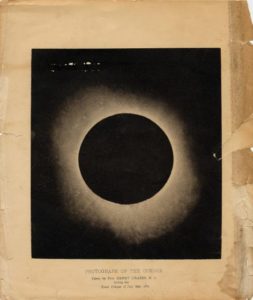 Thomas Edison invented just about everything, or at least got credit for much of it. He even was involved in a total solar eclipse in 1878. Edison had developed a tasimeter to measure infrared radiation, and he wanted to use it to measure the small changes in temperature from the sun during the eclipse.
Thomas Edison invented just about everything, or at least got credit for much of it. He even was involved in a total solar eclipse in 1878. Edison had developed a tasimeter to measure infrared radiation, and he wanted to use it to measure the small changes in temperature from the sun during the eclipse.
Edison had been in Washington, D.C., where he was showing off his new invention – the tinfoil phonograph – to the National Academy of Sciences, followed by a late night private presentation in the White House to President Rutherford B. Hayes. While in the nation’s capital he jumped at an invitation to join a expedition of scientists on their way out to Wyoming to see a total eclipse of the sun, which could be viewed on July 29th. Edison was keen to test his newest invention. The tasimeter, like the phonograph, was an almost accidental spinoff from Edison’s research on telephones, then in hotly contested race to beat Alexander Graham Bell, the young upstart (he was born a month after Edison) from Edinburgh. [Bell won that race]
Like most eclipses, the total solar eclipse of 1878 was a great opportunity to study celestial phenomena and travel with renowned astronomers. Once in Wyoming, Edison set up his tasimeter and recorded minor changes in the heat coming from the distant red giant star, Arcturus. When July 29th arrived, weather conditions were not optimum – a storm nearly blew over the structure protecting the tasimeter and other instruments – but cleared long enough to get a good view. Unfortunately, the tasimeter was too sensitive and the solar emissions of the sun’s corona overwhelmed the tasimeter’s ability to get accurate readings. The idea was a bust, and indeed no huge discoveries were made by any of the scientists on the expedition.
Edison did, however, take advantage of the elite scientific company and continued the trip up into Yosemite, through Nevada (where he descended deep into a silver mine), and greatly enjoyed camping under the stars he had just so scientifically observed. This trip became a prelude to his much publicized annual “camping” trips with friends Henry Ford, Harvey Firestone, and aging naturalist John Burroughs (plus an occasional U.S. president or two).
Returning from his western adventure, Edison dropped the tasimeter idea and shifted his attention to electric lighting, a project that would consume him for several years and set off the “War of the Currents” with Nikola Tesla and George Westinghouse. Someone else would have to study eclipses, Edison was on to other mysteries.
[The above is partially extracted from Edison: The Inventor of the Modern World]
David J. Kent is the author of Lincoln: The Man Who Saved America, now available. His previous books include Tesla: The Wizard of Electricity and Edison: The Inventor of the Modern World (both Fall River Press). He has also written two e-books: Nikola Tesla: Renewable Energy Ahead of Its Time and Abraham Lincoln and Nikola Tesla: Connected by Fate.
Check out my Goodreads author page. While you’re at it, “Like” my Facebook author page for more updates!
Follow me by subscribing by email on the home page. Share with your friends using the buttons below.










